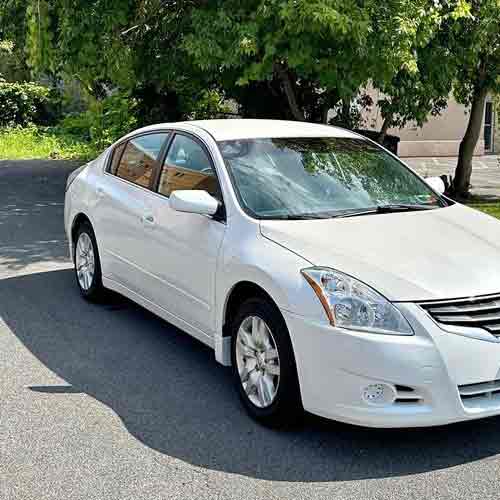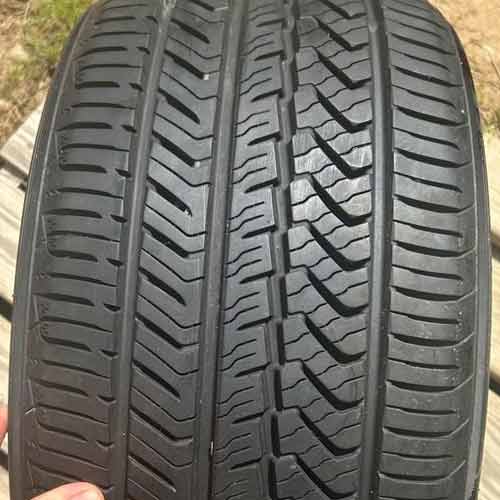The Yokohama Advan Sport A/S+, being an ultra high performance all-Season tire, offers pretty decent overall traction in all conditions, where its innovative HS-2 compound also bring in the needed tread life and economy. Let’s see what else this tire has up its sleeves.

The Yokohama Advan Sport A/S+ excels in dry grip and tread longevity, but struggles with precise steering, understeering, and notable noise levels, impacting the ride comfort. Moreover, while its adequate on wet roads, it displays poor hydroplaning resistance, and its fuel efficiency is compromised due to design contributing to high rolling resistance.
Sizes Info
The Yokohama Advan Sport AS Plus comes in 16 to 21 inches rims, and they have the following specs.
- Speed ratings: W and Y.
- Load ratings: SL and XL.
- Tread depth: 11/32″ on all.
- Weight range: 21 to 33 lbs.
- Treadwear warranty: 55k miles.
- UTQG rating: 440 AA A.
Tread Configuration
The Yokohama’s tire is pretty biting, with its asymmetric tread design.

The tire features 3 central ribs of various shapes, which create 4 circumferential channels.
Out of these grooves, one of them having a pretty tough passing design (with its zigzag structure).
The central most rib is the narrowest, but creates a lot of off-set edges, while the rib on its right (in the image), is the widest, carrying multiple thick lateral in-groove notches and interlocking siping.
The remaining central rib (on the left), although carries similar features, is not that aggressive.
Moving towards shoulders, they carry almost similar features on both sides as well.
Internally, the tire features a single ply polyester casing with twin steel belts, reinforced by spirally wrapped nylon on top.
Compare Yokohama Advan Sport A/S Plus with:
Overall Dry Performance
Dry performance is mainly 3 parts, where 2 are linked with traction, (i.e. directional and lateral grip), while the other tells about the steering characteristics. Let’s check them all out one by one.
Dry Grip
The grip, of a tire refers to its ability to maintain longitudinal stability and is measured by its stopping efficiency.
Now, given its directional nature, this grip is significantly influenced by the central area of the tire tread.
And in this regard, the Yokohama Advan Sport A/S+ sets itself apart, featuring 3 prominent biting ribs, as highlighted in the tread design section (see above).
Not only their continuous running structure offers a consistent rubber to road contact, but the in-groove slanted lateral notches oriented in multiple directions also add to the tire’s overall braking abilities.
So how well is it?
Well, compared to one of its direct competitor, the BF Goodrich G Force AS Plus (review), the Yokohama exhibits minimal differences, lagging only by one foot in a braking distance test.
Handling Grip
In terms of handling, the Yokohama ADVAN Sport A/S+ again showcases superior characteristics, maneuvering through sharp turns with a powerful grip.
In a direct comparison to a “top performing” competitor here, the BFG G Force, our tire only lags by just 0.1 g, in terms of lateral g-force, which measures sideways traction.
Now since lateral grip highly depends on shoulders, this tire designed with intelligent shoulder lugs interconnected longitudinally gets to provide an extensive rubber to road contact, ensuring substantial lateral grip.
Now, although the lugs might seem divided by lateral grooves, they don’t cause any hurdles (in terms of contact patch), as all these shoulder blocks are resting on a secondary rubber layer, and are interconnected with ridges in between.
Now the tire’s impressive lateral traction isn’t the only consideration for overall cornering performance. And this is where steering comes in.
For Your Info: Among all the tires I’ve reviewed in the ultra-high-performance all-season category, the Pirelli All Season Plus stands out, offering the most superior overall dry handling.
Steering Efficacy
Now in terms of steering, the Yokohama Advan Sport A/S+ is responsive enough. And the tire swiftly and effectively responds to all kinds of steering inputs, allowing for quick and efficient directional changes with minimal delay.
But its still susceptible to understeering.
I mean, even though steering response is good, it’s still tricky to feel the exact level of grip or exactly where the wheels are. This might make it hard for drivers to steer “accurately”, as they might not feel how much traction there actually is.
So this becomes the main cause of understeering, where the front of the car doesn’t want to turn.
For Your Info: Don’t confuse steering feedback with the understeering, they are both separate dimensions.
Winter Traction
The Yokohama ADVAN Sport A/S+ comes with all the ingredients that make it a decent performing tire for snowy tracks.
It comes with extensive siping, consisting of interlocking and rectilinear patterns, to enhance ice gripping capabilities.
And as for softer snow, the tire has various elements contributing to its proficient snow grip, including zigzag longitudinal grooves centered on its tread, “slanted” in-groove biters on the internal ribs, and lateral notches on the shoulders.
All these technically capture snow particles, promoting efficient snow-to-snow contact (which is needed, due to the fact that snow adheres better to itself than it does to rubber).
The result is a tire that delivers above-average performance in acceleration, braking, and handling. However, it’s noteworthy that, like others in its category, the Yokohama A/S+ does not hold the 3-peak mountain snowflake rating.
Wet Performance
Exploring wet road performance involves focusing on two critical areas. Traction with steering and tire’s capability to resist hydroplaning. Let’s get into each aspect.
Wet Traction
The Yokohama ADVAN Sport A/S+ is pretty fair under wet conditions, but it still doesn’t match the highest-performing tires in its all-season category.
So, what’s the deal here?
Well, essentially, traction is primarily derived from siping. These (siping) slits basically creative negative pressure, absorbing water, clearing the road slightly, so that the rubber can “grip” effectively.
Now the Advan Sport A/S+ features a combination of interlocking and rectilinear siping, ensuring above-average grip in wet conditions. Moreover, the tire’s biters and in-groove notches on the shoulders also provide adequate lateral grip.
But with the tire lacking steering, the overall handling times don’t get to be so great.
I mean, its wet steering is although responsive enough, it still lacks the needed “precision”. And just like on dry asphalts, the tire tends to understeer here on wet roads as well.
For Your Info: Out of all tires I reviewed in the high performance all season category, the Michelin Pilot Sport All Season 4 offer the best wet braking.
Hydroplaning Resistance
Hydroplaning resistance refers to a tire’s ability to clear water off from grooves, so it would not float.
In this regard, the Yokohama Advan Sport A/S+ isn’t able to stand out.
Due to the “fat” ribs in the middle, the 4 circumferential grooves (they form), aren’t quite wide enough. So the tire isn’t able to throw a good enough amount of water out, longitudinally.
Moreover, its compact shoulder lugs, although providing satisfactory dry grip, also impede “lateral” water displacement.
And so, you get lower straight and cornering aquaplaning speeds in tests (compared to other tires in the category).
So, in essence, when evaluating overall resistance to hydroplaning, (a metric determined by the speed at which a tire can traverse over watery surface), the Yokohama ADVAN Sport A/S+ falls short, overall.
Tread Longevity
Assessing the longevity of a tire’s tread involves an intricate analysis of multiple factors including tread depth, rolling resistance, and the materials used in the tire’s construction.
Now being in the ultra high performance AS tires, although one wouldn’t expect too much here, the Yokohama Advan Sport A/S+ still offers slightly better results compared to its peers.
This tire distinguishes itself by offering a treadwear warranty of 55k miles across all sizes, whereas most competitors usually cap their warranties at 50k miles.
This enhanced durability can primarily be attributed to its composition of stiffer rubber and its comparatively deeper tread.
The less plaint rubber, needless to say, offers more resistance to wear, while the additional tread depth prolongs the tire’s lifespan before it reaches the (legally mandated) replacement level of 2/32″ tread depth in the USA.
Ride Quality
High Performance tires, like the Yokohama here often prompt concerns regarding ride comfort, particularly around aspects of road noise reduction and impact comfort.
Let’s discuss these two main factors here.
Ride Comfort
The Yokohama Advan Sport A/S+ delivers a level of ride quality comparable to that of average performance tires, where its able to mitigate minor impacts and surface irregularities.
Though the tire still faces some challenges, when it comes to bigger, substantial bumps, where the tire’s flexibility seems to reach its limit sooner.
This is mainly because the tire although offers a good soaking rubber on top, still employs a much stiffer inner construction.
Though ironically, the very same internal construction, also helps this tire to have handling stability as well.
Noise Generation
When assessing noise generation, the Advan Sport AS+ leaves room for improvement, ranking as one of the noisier options within its category of high-performance all-season tires.
I mean, the tire produces distinct resonances over concrete, accompanied by a substantial amount of, what I like to call, growling noise.
This prevalent noise continues even on smoother surfaces, where its more of a cyclic vibrato.
Now, although there are multiple contributors to these “unwanted sound waves”, the primary culprit is the tire’s aggressive asymmetrical tread design, which lacks proper optimization for pitch sequencing technology.
This results in noise levels that are more pronounced, impacting the overall auditory comfort of the driving experience.
Fuel Consumption
Fuel efficiency is closely linked to a tire’s rolling resistance, influenced mainly by its weight, rubber composition, and tread design.
And here, the Yokohama ADVAN Sport A/S+ is not impressive at all.
Although the tire features a “flatter contour profile”, designed to optimize the contact patch and uniformly distribute pressure for extended duration, and a light weight internal construction (with a single ply polyester + nylon cap ply), its performance is still underwhelming.
But why? Well there are two key areas here, causing problems for this tire.
Firstly, its asymmetric design populated with abundant “biters”, amplifies the friction between rubber and road, significantly.
And secondly, the tire’s tread depth of 11/32″ induces lug flexing (where most of its competitors don’t go above 10/32″).
Basically its greater tread causes lugs to move more excessively, and that does not preserve energy (which is actually spent in reshaping distorted lugs and heat).
I should also mention that although the difference of 1/32″ in tread depth may seem negligible, it still plays a substantial role when it comes to overall rolling resistance and fuel efficiency.
To Conclude
The Yokohama Advan Sport A/S+ offers admirable dry grip and adequate handling but falls short in steering efficacy, exhibiting susceptibility to understeering.
Its performance on wet roads is fair, hindered by sub-optimal hydroplaning resistance due to inadequately wide circumferential grooves and compact shoulder lugs, impacting both straight and cornering aquaplaning speeds.
As for the winter traction, its overall above-average, where slight improvement can be made when it comes to ice.
It offers good enough tread life, other than that.
But its fuel efficiency is compromised due to its design and tread depth, contributing to increased rolling resistance.
And yes, it also needs to improve its overall comfort as well. Though its understandable still its a “high performance” tire.